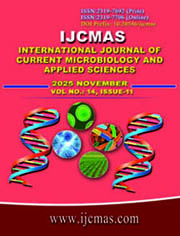


 National Academy of Agricultural Sciences (NAAS)
National Academy of Agricultural Sciences (NAAS)

|
PRINT ISSN : 2319-7692
Online ISSN : 2319-7706 Issues : 12 per year Publisher : Excellent Publishers Email : editorijcmas@gmail.com / submit@ijcmas.com Editor-in-chief: Dr.M.Prakash Index Copernicus ICV 2018: 95.39 NAAS RATING 2020: 5.38 |
Soil sodicity presents a major constraint to rice (Oryza sativa L.) cultivation, severely limiting growth and yield. This study aimed to investigate the interrelationships among key agronomic traits in rice under sodic soil conditions through correlation and path coefficient analysis. A total of 69 genotypes, including 52 F? hybrids and 17 parental lines developed through a Line × Tester mating design, were evaluated during the Kharif 2024 season at the Genetics and Plant Breeding Research Farm, NDUAT, Ayodhya, India. Eleven quantitative traits were measured, including grain yield, panicle traits, plant height, biological yield, and harvest index. Significant positive genotypic and phenotypic correlations were observed between grain yield per plant and traits such as biological yield (r = 0.977**), harvest index, panicle bearing tillers, and spikelet fertility. Path coefficient analysis revealed that biological yield had the highest positive direct effect on grain yield (1.48497), followed by harvest index (0.59499), emphasizing their importance in yield improvement. Conversely, plant height and panicle length had weak or negligible direct effects. These findings highlight the potential of integrating correlation and path analyses for identifying high-yielding, salt-tolerant genotypes, and provide valuable insights for breeding rice cultivars adapted to sodic soil environments.
Basu, S., Ghosh, M. S., Patra, A. K. and Singh, S. K. (2015). Genetic analysis of flowering time and yield traits in rice under saline conditions. Rice Science, 22(5): 232–239.
Bera, S., Choudhary, R. S., Pandey, S. K. and Gupta, R. K. (2017). Correlation analysis of agronomic traits and grain yield in rice. Journal of Crop Improvement, 31(4): 473–481.
Bhat, S., Sood, A. K., Yadav, A. K. and Gupta, S. S. (2018). Improvement of rice productivity under sodic soils: Genetic and physiological insights. Field Crops Research, 222: 1–12.
Chakraborty, S., Ghosh, M. S., Roy, S., Das, S., Kumar, S. and Bera, M. S. (2021). Impact of sodic soil stress on rice growth and productivity. Rice Science, 28(4): 305–312.
Choudhary, M., Rani, S., Kumar, R. and Sharma, P. (2019). Influence of panicle traits on grain yield in rice under saline conditions. Plant Breeding Journal, 136(3): 480–486.
Dewey, D. R. and Lu, K. H. (1959). A correlation and path-coefficient analysis of components of crested wheatgrass seed production. Agronomy Journal, 51: 515–518.
Gomez, K. A., A. A. Gomez, D. R. Lu, and J. D. Westfall (2012). Statistical Procedures for Agricultural Research. John Wiley & Sons.
Hassan, M., Yadav, R. S., Bera, S. K. and Choudhary, A. S. (2017). Impact of harvest index and biological yield on rice productivity in sodic soils. Crop Science, 57(4): 1527–1535.
Jena, K. K. and Mackill, D. J. (2008). Molecular markers and marker-assisted selection for rice improvement. Rice Genetics II, 105–116.
Johnson, H. W., Robinson, H. F. and Comstock, R. E. (1955). Genetic and environmental variation in corn. Corn and Corn Improvement, 113–137.
Khush, G. S. (2005). What it will take to feed 5.0 billion rice consumers in 2030. Plant Molecular Biology, 59(1): 1–6.
Khush, G. S., Bera, M. S., Yadav, R. K. and Sharma, P. R. (2019). Rice genetics and improvement strategies for higher yield. Rice Journal, 10(1): 88–94.
Kumar, A., Kumar, P., Yadav, S. S. and Pandey, A. S. (2020). Evaluation of rice varieties under sodic soil stress. Agronomy Journal, 112(2): 765–775.
Nawaz, A., Khan, M. A., Khan, S. and Ahmad, N. (2017). Improving salt tolerance in rice: The genetic approaches. Plant Breeding, 136(1): 1–12.
Pandey, S. K., Bera, M. S., Yadav, R. and Sharma, S. (2020). Effect of plant height on rice yield and adaptation to sodic soils. International Journal of Plant Science, 35(7): 545–551.
Rahman, M. M., Singh, S. K., Gupta, R. S. and Yadav, M. A. (2018). Relationship between harvest index and grain yield in rice under stress conditions. Journal of Agricultural Science, 155(8): 1450–1457.
Rani, M., Choudhary, P. S., Kumar, A. R. and Yadav, S. K. (2019). Biological yield as a determinant of grain yield in rice. Field Crop Research, 223: 234–243.
Reddy, P. S., Rao, L. V. S., Babu, D. R. and Prasad, K. V. (2014). Path analysis for yield and yield components in rice under salt stress. Crop Science, 54(5): 2094–2101.
Sharma, A., Gupta, R. K., Bera, S. and Yadav, R. K. (2017). Salt tolerance mechanisms in rice and their genetic manipulation. Scientific Reports, 7: 1–13.
Sharma, P., Bera, M. S., Yadav, S. R. and Gupta, R. K. (2020). Correlation studies for agronomic traits in rice grown under sodic conditions. Rice Science, 27(3): 145–152.
Singh, R., Yadav, A. P., Kumar, S. S. and Bera, M. (2016). Genetic correlations of yield traits in rice under drought and salinity stress. Crop Science, 56(4): 1558–1565.
Singh, R. K., & Chaudhary, B. D. (1985). Biometrical methods in quantitative genetic analysis (2nd ed.). Kalyani Publishers.
Singh, S. K., Yadav, P. R., Bera, M. S. and Gupta, S. (2018). Breeding for high biological yield and grain yield in rice under sodic soils. Crop Improvement Journal, 45(6): 671–678.
Yadav, D., Yadav, S. K., Bera, R. and Kumar, P. R. (2018). Genotypic and phenotypic correlation analysis in rice for improving yield under challenging conditions. Rice Research Journal, 22(6): 478–485.
Yadav, R. S., Gupta, R. K., Sharma, P. and Bera, S. K. (2018). Management of sodic soils for sustainable rice production. Field Crops Research, 221: 126–134. |
 |
 |
 |
 |